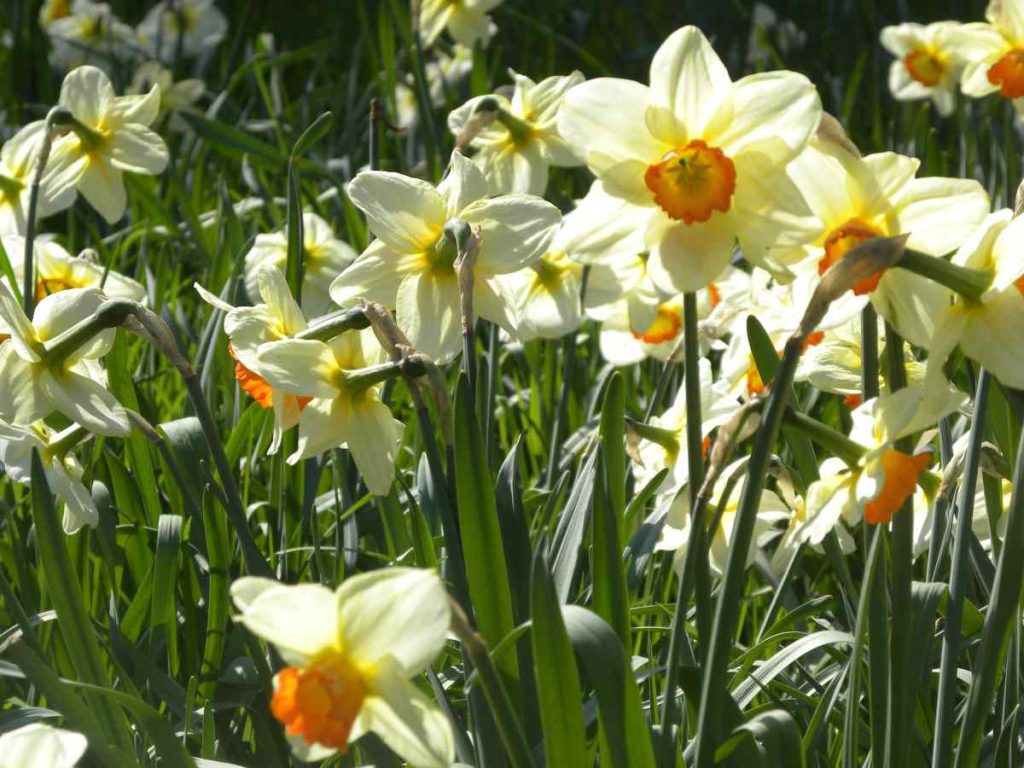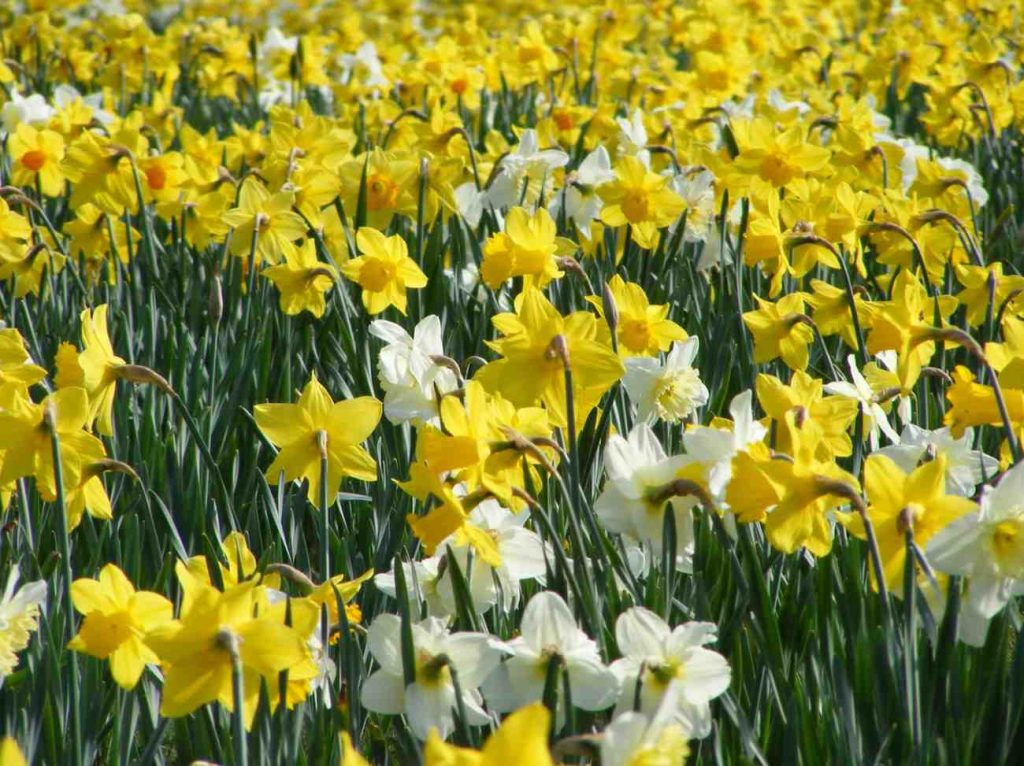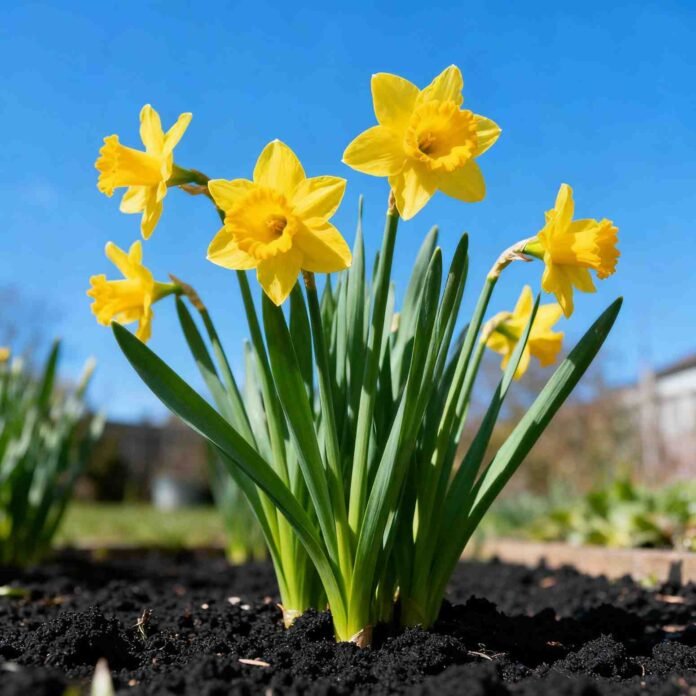As a gardener, seeing yellowed coloured trumpet-shaped blooms of daffodil plant is first sign of spring.
To beautify your garden with spring colors, you’ve to think ahead by planting daffodil bulbs in the fall.
These easy to grow perennial flowering plants require 6 hours of sunlight but can tolerate shade. Though they bloom in spring, but cold temperature in winter allows them to get out of dormancy and establish strong roots.
Hardy to USDA zones 3-8, Daffodil plants can be grown outdoors. But you need to plant the bulbs before the ground freezes.
In simple words, fall (early October to November) is the best time to plant daffodil bulbs.
Before jumping to planting, lets understand growing needs of this perennials.
Growing Requirements of Daffodils
Though it can tolerate shade, 6 hours of direct sunlight is essential for healthy blossoms.
Now, let’s check soil, water and sunlight needs in brief.
- Daffodils grow best in full sun to partial shade, needing at least 6 hours of sunlight each day; select a spot with well-drained soil to prevent rot and encourage healthy root formation.
- Plant bulbs in early fall, ideally between September and November, at a depth of 4-6 inches and spaced 3-6 inches apart for proper growth and future division.
- Water the bulbs well after planting to help them settle, then keep the soil moderately moist during the spring growing season, avoiding overwatering to prevent bulb rot.
- Apply a balanced fertilizer in late winter or early spring before blooming; remove faded flowers after blooming and divide clumps every few years to maintain vigorous plants.
How to Plant Daffodil Bulbs in Fall?
In fall, the garden soil is still workable but cool enough to encourage root development before the cold winter months set in, making it perfect for cold-hardy plants like daffodils.
When planted in fall, daffodil bulbs root well as temperatures drop, then enter dormancy during winter while they prepare internally for growth.
The cooler fall soil stimulates root formation, and regular autumn moisture helps the bulbs settle without rot.
After winter’s chill triggers spring awakening, healthy green shoots and blooms emerge, brightening gardens across many regions. This natural rhythm makes fall planting essential for daffodil success each year.

Choosing the planting location
Daffodils thrive in full sun to partial shade, ideally receiving at least six hours of direct sunlight each day. This light helps the leaves recharge the bulb’s energy for the next year’s growth.
Soil Preparation
- Choose well-draining soil; soggy ground can cause bulbs to rot. Add organic compost or sand to improve drainage if needed.
- Maintain slightly acidic to neutral soil (pH 6.0–7.0).
- Avoid planting where water puddles linger after rain.
Check this: 27 Best Fall Flowering Plants to Beautify Autumn Garden
Sunlight requirement
According to daffodil grower Brent Heath, daffodil leaves act as “solar collectors” that store sunlight energy for next year’s bloom. Therefore, pick a site that remains sunny even after surrounding trees leaf out in late spring.
Planting Daffodil Bulbs

Daffodil are hardy bulbs that thrive with minimal care, but success starts with choosing the right ones. Always choose firm, healthy bulbs—avoid any that feel soft or show signs of mold. Larger bulbs usually produce stronger blooms.
You’ll also want to consider variety. From classic yellow trumpet daffodils to white, orange, or even pink cultivars, there’s a wide range to suit different garden styles.
Early-, mid-, and late-season types can be mixed to extend the flowering period for weeks.
Once you’ve chosen the best bulbs for your climate and design, proper planting in fall ensures they’ll reward you with bright, reliable blooms every spring.
1. Timing
Fall is the best season to plant daffodil bulbs—anytime from September to November, depending on your local climate.
The goal is to get them in the ground before the soil freezes, so the bulbs have enough time to establish roots while temperatures are still cool. This early start helps them store energy for a strong spring bloom.
If you wait too long and the ground hardens, the bulbs won’t have time to root properly. In warmer regions, you can plant them a bit later, but in colder areas, it’s better to get them in early fall. Just make sure the soil temperature has dropped below 60F before planting.
Also Read: 15 Flowers to Plant in November
2. Depth and Spacing
When planting, dig each hole about 4–6 inches deep—roughly three times the height of the bulb. Always position the pointed end facing up; that’s where the stem will emerge. Cover the bulbs with soil and gently press it down to remove air pockets.
Give each bulb enough breathing room by spacing them 3–6 inches apart. This prevents crowding, ensures good airflow, and allows each plant to develop a strong root system. Over time, daffodils will multiply, filling in the gaps naturally.
3. Positioning
For a more natural look, toss the bulbs lightly over your chosen area and plant them where they land. This creates an effortless, meadow-like display that looks less rigid and more organic once the flowers bloom. It’s a simple trick that works beautifully in lawns or informal garden beds.
If you prefer a more structured layout, plant in layers. Taller varieties can go toward the back of borders, with shorter ones in front. You can also mix daffodils with other spring bulbs like tulips or hyacinths for a longer-lasting show of color.
4. Watering
After planting, give the bulbs a deep drink of water. This helps settle the soil and kickstarts root growth before winter sets in. Once that’s done, you can mostly leave them alone—the bulbs will rest through the cold months until spring warmth brings them back to life.
Unless you’re in a particularly dry region, extra watering isn’t needed after that first soak. Daffodils prefer well-drained soil and can rot in soggy conditions, so it’s better to err on the dry side during the dormant period.
Check this: How to Grow Asters for Fall Blooming?
How to Care for Daffodils After Planting?
- Watering: Give them a good soak right after planting so the bulbs settle in. After that, just water occasionally if the weather stays dry—daffodils don’t like soggy soil.
- Mulching: Spread a thin layer of mulch over the area to keep the soil moist and cozy. It also helps protect the bulbs from winter chill and keeps weeds down.
- Fertilizing: When new shoots start popping up in spring, sprinkle a bit of balanced bulb food around them. Skip high-nitrogen fertilizers—they’ll make more leaves than flowers.
- Weed Control: Keep the bed tidy by pulling out any weeds nearby. Be gentle, though—you don’t want to disturb the bulbs resting just below the surface.
- Post-Bloom Care: Once the flowers fade, let the leaves hang around until they turn yellow. They’re busy soaking up sunlight and feeding next year’s blooms, so patience pays off.
Common Mistakes to Avoid
When planting daffodils, one common mistake is setting the bulbs too close to the surface. They need a bit of depth to stay safe from frost and to grow strong stems. Too shallow, and they might freeze or flop over when they bloom.
Another thing to watch out for is overwatering. Daffodils like their soil slightly moist, not soggy. Too much water can cause the bulbs to rot before they even get a chance to grow. Pick a sunny spot too—these flowers really love light and won’t do well in heavy shade.
And don’t rush to tidy up after they bloom! The leaves may look a bit scruffy, but they’re still feeding the bulb for next year’s flowers. Let them die back naturally before cutting them off—it’s the best way to keep your daffodils happy and blooming again next spring.
Also Read: 19 Fall Wildflowers for Late Season Color
Conclusion
Planting daffodils in fall is one of those small garden tasks that pays off in a big way come spring.
With a little care—choosing healthy bulbs, planting at the right depth, and letting the leaves fade naturally—you’ll be rewarded with bright, cheerful blooms year after year.
These flowers are tough, dependable, and add a burst of sunshine when everything else is just waking up. So take the time now, and your garden will thank you when spring rolls around.

Khaja Moinuddin, a computer science graduate, finds joy in gardening and homesteading. Join him on this blog as he shares his experiences in homesteading, gardening, and composting


